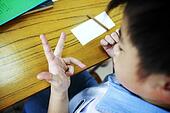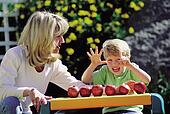After our quiz we actually discussed on solving the sum,
in 4, how many 2/3's are there?
Therefore, if 4 cakes were shared equally, and each person can get 2/3 of a cake, how many people received 2/3 of the cake?
This was solved using 4 square diagrams, divided into three equal parts, how many 2/3's are there now?
We were also given ideas on multiplication activities on Hort Park.
Recently, my school visited Jacob Ballas Garden. Children were given mathematical tasks of adding number of petals the flowers have,the number of trees and etc..
I enjoyed the story of of the book titled 'How big is a foot?' It really teaches or introduces the topic of length to a child in an interactive and enjoyable manner.
The last second activity i enjoyed was the short getaway from class where we went to measure from one floor to another. I used a metal ruler so mine began from the '0cm' mark. However the other rulers did not. And some of them could not come up with an accurate answer and had a decimal place Therefore, I measured each staircase step and my calculation was 15cm exactly. And i went down and climbed up 62 steps. SO I mutiplied 62 by 15cm which gave me 930cm, which is about 9.3m Im not sure if this was right but some of my classmates were arguing about the horizontal space in between each step should be measured but I felt it was not necessary as that was not calculating the height of the staircase.
Ours could hold so many times of 15
The last activity was making a cube or cuboid for 15 kidney beans. First I came up with the outline for the box as the rest werent sure of it, however I had to really change my cube to cuboid to make it smaller for 15 kidney beans. Even so it was still very bigleaving so much space empty. So it was a failure, sigh.. But I learnt from my mistake. Math is all about trying and experimenting and learning from old mistakes. I appreciate this subject more now.















